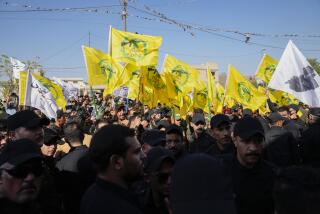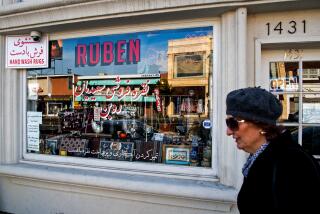Inside a Moujahedeen Camp: The Face of Iran-to-Be?
BAGHDAD, IRAQ — More than a few American universities are unknowingly making a direct and forceful contribution to the liberation of Iran from the rule of the Ayatollah Ruhollah Khomeini and his mullahs. The contribution is in the form of alumni serving as soldiers and officers in the ranks of the National Liberation Army of Iran.
The NLA is the combat element of the socialist Moujahedeen (“Holy Warriors”) movement that has become the most effective group in opposition to the Khomeini regime--thanks in large part to French Prime Minister Jacques Chirac. Yielding to Iranian pressure, he expelled Moujahedeen leader Massoud Rajavi and many of his followers from France in June, 1986. They went to Iraq and began armed raids into Iran last January; by June, having grown in size and effectiveness, the Moujahedeen forces were combined into the National Liberation Army.
The NLA claims it has been responsible this year for nearly 100 attacks, for taking 836 prisoners of war and provoking 3,000 desertions from the Iranian forces. These last two figures are verifiable, because the deserters and prisoners are there to be seen, except for the 170 POWs recently sent home to celebrate the prophet’s birthday. Less sure are the NLA claims to have killed and wounded 8,250 Iranians for minimal losses on its side.
The Moujahedeen, having survived underground for many years under the Shah of Iran and then under Khomeini, is intensely secretive--or security conscious--which is why last week I was the first journalist from any country to visit an NLA unit, in this case, the headquarters of the northern command, located in an area that I have agreed to identify only as not in central Iraq.
The first surprise was to see a woman doing sentry duty at the main gate of the headquarters; a third of the NLA’s forces are female. Considering Khomeini’s grim anti-feminism, the large presence of women in the NLA is most striking. With the addition of a head scarf, they wear the same uniforms as the men and carry the same weapons. All units are mixed, even in the artillery, and some mixed units are commanded by women. Though not serving in the front lines, women have crossed the Iranian border and come under artillery fire.
The first recruits to answer the call to arms were, as might have been expected, young idealists among the tens of thousands of Iranian students abroad, many of them Moujahedeen members in the universities of the United States, Britain, Western Europe and even India. Their presence makes the NLA one of the most highly educated armies in the world (the headquarters library and reading room was full of people). Volunteers--and the whole NLA is voluntary--are still coming in from universities abroad, from inside Iran and from Iranian army deserters, so the NLA is a growing force. These well-read soldiers-in-exile have not only sacrificed their educations and careers but also their immediate financial prospects because there is no pay in the NLA: It is their home and takes care of everything. Those who need money for their families ask for and receive specific sums but get no regular salaries.
Because of the NLA’s secretiveness I could discover no firm figure for the numbers of men and women in NLA battalions and brigades, as they label them. An educated guess might be 15,000 overall. Their baggy, green U.S.-style uniforms have no knife-edge creases but were clean and spruce; boots were polished, so were the weapons and the motor transport. No epaulets, no badges of rank and no saluting. Yet, because there have to be officers and other ranks in any army, the soldiers did snap to attention, clicking heels together, in the presence of those who were clearly of different status. So military protocol was there, but of an informal, relaxed variety. No relaxation in the well-ordered tidiness and neatness of the troops and barracks--all very traditionally military.
Perhaps the neatest office of all was the operations room. It was conventionally equipped with a generous display of maps in all scales (some of them captured) and photo-mosaics proudly displayed to me by a staff officer carrying that inescapable badge of office, a long pointer. Particularly impressive was an array of sand-table models of the sites in Iran of past and probable future battles. What struck me was that they were full of details of the Iranian positions. One model of the area covered by an Iranian division between Mariyan and the Iraq border was peppered with scores of flags showing every unit of that division down to platoons--one poor divisional Iranian commander naked to his enemy.
This detailed knowledge of what is there “on the other side of the hill”--every commander’s first requirement--comes from continuous reconnaissance on the ground, from “friends” in the enemy ranks and from prisoners and deserters.
Officers who had taken part in the latest and largest battle in the Piranshahr area, where 310 prisoners were taken, explained that because of excellent intelligence they were able to surprise the enemy by surrounding his positions, usually at night. The NLA then used its superior fire power to bring down a heavy enveloping barrage. The shocked garrisons were then bombarded from loudspeakers with the news that the attackers were not Iraqis but Iranians; they called for surrender before the actual attack began. Perhaps because of these tactics, perhaps because of low Iranian morale, the NLA claims it does not find the Iranian soldier a tough, dedicated fighter but one quite ready to run or give in. A Pasdaran, or Revolutionary Guard, pressed into service cannot be expected to have the commitment of an educated volunteer.
The NLA must receive considerable support from Iraq, now in the eighth year of its war with Iran. But I was told, emphatically, “We coordinate with the Iraqi army but we do not collaborate--for instance, we do not ask for supporting artillery fire.” During the last few months, however, NLA attacks--especially in the sensitive southern area of Khuzistan, not far from the vital Basra sector--have meshed with Iraqi strategy.
Because the Iraqis can only fight a defensive war on their side of the border, the NLA functions as a forward, offensive screen, launching surprise and disruptive attacks behind the Iranian lines. Compared with the large numbers that constitute the Iraqi and Iranian armies, the NLA is a small force, dynamic and elite. But its significance is large, as a symbol of the new Iran-to-be, embodying the values and goals of the liberation movement.
The Khomeinists know the NLA’s presence is a threat to them--which is why they have been trying to push it out of France. They fear the NLA because it shows that not all Iranians are cowed by the terror of the mullahs’ regime and that these young Iranian men and women are prepared to fight and die for a very different sort of nation.
More to Read
Sign up for Essential California
The most important California stories and recommendations in your inbox every morning.
You may occasionally receive promotional content from the Los Angeles Times.










